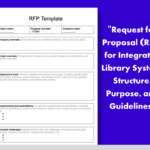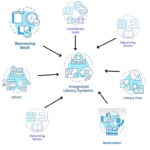The history of library management software is closely linked to the evolution of computers and digital technologies.
Below is a concise timeline outlining the key phases and milestones:
1. Pre-Digital Era (Before 1960s)
Manual Cataloging: Libraries relied on card catalogs, ledgers, and manual indexing systems to track inventory and loans.Classification systems such as the Dewey Decimal Classification (1851) and the Library of Congress Classification provided foundational organization.
2. Early Computerization (1960s–1970s)
- 1960s: Large academic libraries began using mainframe computers to automate parts of cataloging and circulation.
- 1965: The Stanford BALLOTS system (Bibliographic Automation of Large Library Operations) became one of the first major automated systems.
- 1971: The OCLC (Online Computer Library Center) was founded, enabling shared cataloging among member libraries and reducing duplication of effort.
3. Rise of Integrated Library Systems (ILS) (1980s–1990s)
Integrated Library Systems (ILS) emerged in the 1980s and 1990s to unify core library functions such as cataloging, circulation, acquisitions, and the Online Public Access Catalog (OPAC) into a single software suite. Key systems from this era included Dynix (introduced in 1983), Innovative Interfaces, SirsiDynix, and VTLS. These platforms typically operated on local servers using a client-server model, allowing libraries to manage operations more efficiently. During this time, the MARC (MAchine-Readable Cataloging) format also became the standard for structuring bibliographic records, enabling consistent data exchange and interoperability across systems.
4. Web-based and Modular Systems (2000s)
A significant shift occurred with the adoption of web-based OPACs, enabling remote access for users and expanding library services beyond physical locations. This period also saw the introduction of modular system architectures, allowing libraries to customize their platforms by selecting specific features such as e-resource management and discovery layers. Additionally, integration with technologies like RFID, self-checkout systems, and support for digital collections became widespread, enhancing operational efficiency and user convenience.
5. Cloud-based and Open Source Solutions (2010s–Present)
Cloud computing has enabled the development of scalable and cost-efficient library systems, such as Ex Libris Alma and OCLC’s WorldShare Management Services. At the same time, open-source ILS platforms like Koha—first released in 2000 and widely adopted in the 2010s—and Evergreen have gained popularity for their flexibility and community-driven development. There has also been a growing emphasis on interoperability through APIs and standards like Z39.50, Linked Data, and BIBFRAME. Libraries increasingly focus on enhancing user experience, offering mobile access, and leveraging analytics to improve services and decision-making.
6. Current and Future Trends (2020s and Beyond)
In the 2020s and beyond, current and future trends in library management systems include the exploration of Artificial Intelligence (AI) and machine learning for tasks such as metadata enrichment, automated cataloging, and personalized user recommendations. Libraries are increasingly integrating their systems with digital archives, research repositories, and learning management systems (LMS), creating a more interconnected digital ecosystem. Additionally, there is a growing shift toward Library Services Platforms (LSPs), which aim to unify print, digital, and cloud-based resources within a single, comprehensive framework to streamline operations and enhance service delivery.

Here are some notable library management software systems, organized by type and popularity, along with detailed descriptions for each:
A. Proprietary / Commercial Systems
These systems are extensively adopted in various library settings, including academic, public, and special libraries:
1. Libris Alma
Alma is a sophisticated, cloud-based Library Services Platform (LSP) that facilitates comprehensive resource management for academic institutions. It provides an integrated solution for managing physical, electronic, and digital collections, allowing libraries to streamline their operations and maximize resource utilization. Alma supports advanced analytics and reporting tools that help libraries make data-driven decisions.
Libris Alma is used by major academic and research libraries worldwide, including institutions like Harvard University and the University of Oxford.
2. WorldShare Management Services (WMS) – OCLC
WMS is a robust cloud-based library management solution that excels in global cataloging and resource sharing capabilities. Its platform integrates seamlessly with other OCLC services, enhancing bibliographic data and collaboration among libraries worldwide. WMS is particularly beneficial for libraries seeking to improve their resource access and patron engagement through shared collections.
WorldShare Management Services (WMS) by OCLC is used by libraries worldwide, including prominent institutions like the University of Manchester Library and the University of Delaware Library.
3. SirsiDynix Symphony & Horizon
SirsiDynix offers two long-established Integrated Library Systems (ILS). Symphony is known for its modernized interface and support for cloud deployment, while Horizon is a legacy system with a loyal user base. Both solutions offer extensive features, including patron management, circulation, and reporting tools, making them suitable for a variety of library environments.
Many public and academic libraries worldwide, including the Los Angeles Public Library and King County Library System, use SirsiDynix Symphony and Horizon software to manage their library operations.
4. Innovative Interfaces (Polaris, Sierra)
The Polaris and Sierra systems serve distinct library needs. Polaris is predominantly used in public libraries, known for its user-friendly interface and strong focus on public service workflows. In contrast, Sierra caters more to academic libraries, emphasizing cataloging, acquisitions, and advanced analytics functionalities that empower librarians to provide enhanced services.
Innovative Interfaces’ Polaris and Sierra software is used by numerous public and academic libraries worldwide, including large systems like the Chicago Public Library and California State University libraries.
5. Spydus – Civica
Spydus is a versatile library management solution that has gained traction primarily in Australia, Asia, and the UK. It combines traditional ILS functions with digital asset management and mobile integration capabilities. Spydus is known for its flexibility, allowing libraries to adapt the software to their specific needs, thereby improving user experiences and operational efficiency.
Spydus, developed by Civica, is used by public libraries worldwide, including major systems such as the Singapore National Library Board and various UK local council libraries.
B. Open Source Systems
These systems are celebrated for their adaptability, support from a global community, and cost-efficiency:
- Koha: Koha stands out as the first open-source Integrated Library System, first released in 2000. It has garnered a diverse user base, ranging from small community libraries to large academic institutions worldwide. Koha offers a comprehensive set of features including cataloging, circulation, and a customizable online public access catalog (OPAC), making it a favorite for libraries that value community-driven development and flexibility.
Koha is used by a wide range of libraries worldwide, including public, academic, school, and special libraries, with notable adopters like the American University of Nigeria Library and the Nepal Library and Information Consortium.
- Evergreen: Evergreen is specifically designed for consortia and public libraries, providing a scalable and robust platform that emphasizes effective circulation and advanced cataloging functionalities. It supports a wide range of library management tasks, enabling libraries to improve service delivery and enhance collaboration among multiple institutions within a consortium.
Evergreen is widely used by public library consortia, notably the Georgia Public Library Service (PINES), which manages over 275 libraries across Georgia, USA.
- FOLIO (The Future of Libraries is Open): FOLIO represents a collaborative effort between libraries and vendors such as EBSCO, designed as a modular and API-driven open-source LSP. This innovative platform allows libraries to select and integrate specific modules based on their needs, offering tremendous flexibility and customization options. FOLIO focuses on enhancing library productivity through its adaptable interface and supporting multiple resource management functions.
C.Specialty or Lightweight Systems: These systems are typically suited for schools, smaller libraries, or specialized contexts:
1. LibraryWorld: LibraryWorld is a cloud-based library management solution known for its user-friendly interface, making it an ideal choice for smaller libraries and schools. It provides essential library functions such as cataloging and circulation management, along with web-based accessibility, enabling libraries to operate efficiently without investing in extensive IT infrastructure.
2. Destiny Library Manager – Follett: Destiny Library Manager is a popular choice in K–12 educational settings, seamlessly integrating with Follett’s suite of educational resources. This system supports comprehensive library management, including inventory control and digital content access, effectively enhancing the educational experience for students and teachers alike.
3. OPALS (Open-source Automated Library System): OPALS is a web-based library management system that caters primarily to smaller institutions and educational environments. Its open-source framework allows for significant customization, enabling libraries to tailor functionalities to suit their specific operational needs. OPALS is recognized for its affordability and ease of use, making it a practical solution for schools and small libraries looking to enhance their management capabilities.
Although library management software is used in advanced libraries, the usage rate in small and medium sized libraries is very low. Most of those who are using them are not able to use the software effectively for various reasons. The price of the software, purchase, after-sales service and quality of service are important considerations in the field of library management software.



